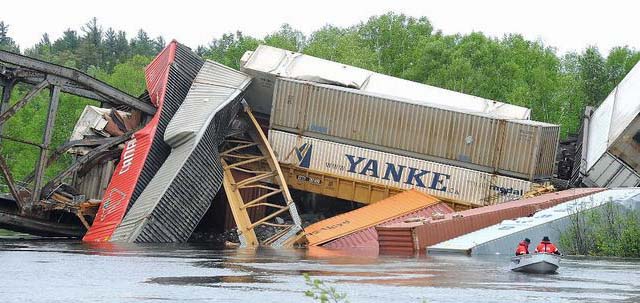|
The site of the derailment - Date unknown Gino Donato.
11 November 2014
Board Details Cause
of Sudbury Derailment
Sudbury Ontario - A catastrophic failure of a roller bearing and subsequent burnt-off axle journal on the first car behind the
locomotives were contributing factors in a June 2013 derailment near Sudbury.
The Transportation Safety Board of Canada (TSB) identified the causes the accident following an investigation that lasted more than a year.
TSB Railway Investigation Report R13T0122.
The derailment happened on Highway 537 in the community of Wanup, about 20 kilometres south of Sudbury.
One rail car was submerged in water, its red roof barely visible under the rushing current.
No one was hurt.
Several area residents told The Star the portion of the bridge that collapsed had work done on it in the past few years.
Someone who lives near the site of the derailment said she heard "a very loud noise" the morning of the accident.
"It was around 10:00," said the woman, who asked that her name not be used.
"I was in the shower."
The woman left her house to see what happened and was stuck behind an Ontario Provincial Police and Greater Sudbury Police barrier on Highway 537.
She wasn't sure when she'd be allowed through.
"Two rail cars floated right by our house," she said.
This is the second derailment in less than two years in that area.
In October 2011, six of 91 cars on a CP freight train went off the track.
In its report, the board said that on 2 Jun 2013, a Canadian Pacific Railway freight train was heading north on the Parry Sound Subdivision when six intermodal
cars derailed as the train approached the bridge over the Wanapitei River.
Some of the derailed cars impacted and severely damaged the bridge, while a number of the cars and containers fell down the embankment and into the
river.
No injuries were reported.
The investigation also determined that when reconditioned roller bearing components are used, bearing service life is further reduced.
Because the roller bearing failed between CP Hot Box Detector (HBD) stations, the investigation further concluded that when HBD systems are not configured for
real-time monitoring and data trending, roller bearings which are beginning to fail may not be detected before failure.
The Transportation Safety Board is an independent agency that investigates marine, pipeline, railway, and aviation transportation occurrences.
Its sole aim is the advancement of transportation safety.
It is not the function of the board to assign fault or determine civil or criminal liability.
Anonymous Author.
|


